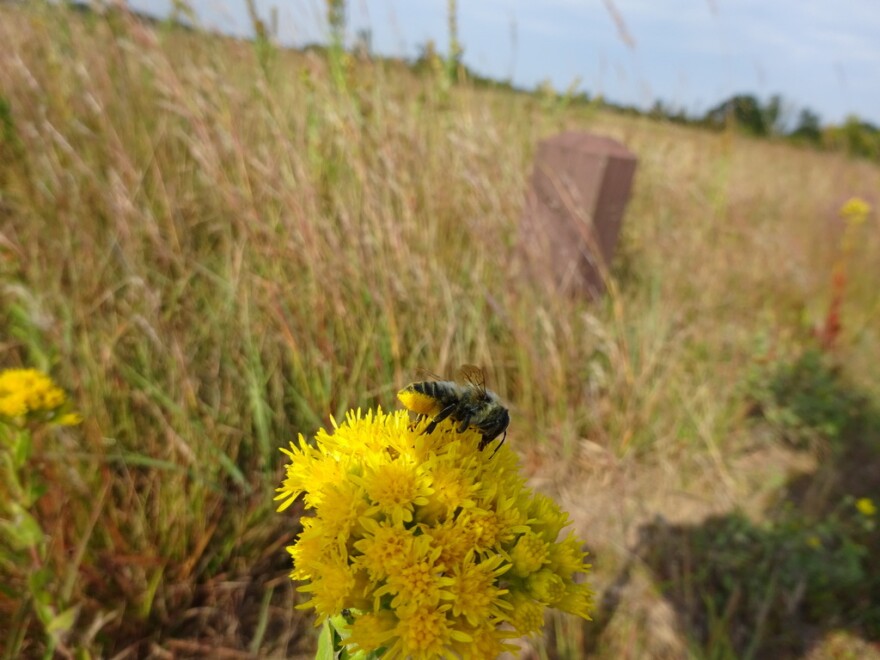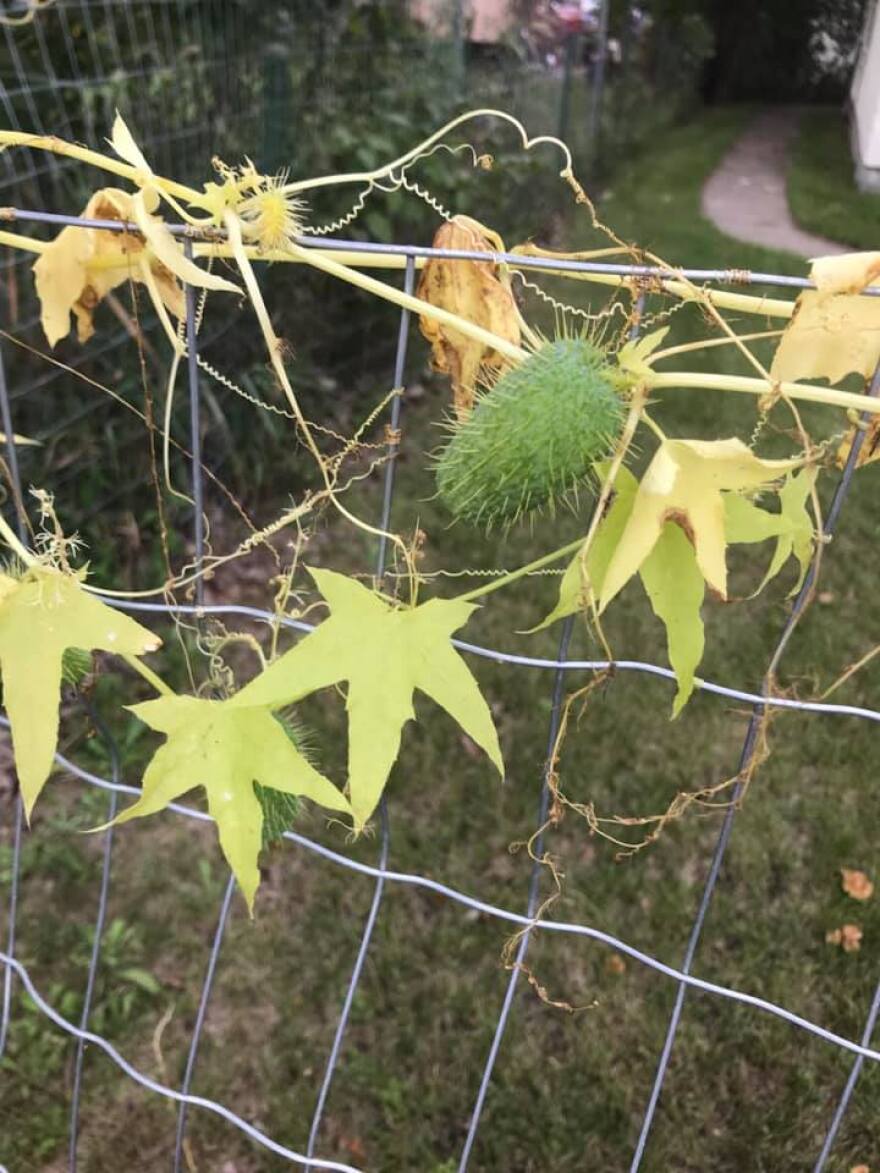This week, we rejoice in the return of our K-12 phenology classrooms! We have four reports this week, ranging from Palisade, Minnesota all the way to Amherst, Massachusetts.
Please don’t hesitate to reach out with your observations, nature tales and insights! Get in touch with me (smitchell@kaxe.org), John Latimer (jlatimer@kaxe.org), or text "phenology" to 218-326-1234.
Long Lake Conservation Center near Palisade

Anna, a new naturalist at Long Lake Conservation Center, sent in this report:
“The Long Lake otter family was spotted frolicking in the lake, and three fawns were observed crossing the path on campus. They all were very close to the same size and have lost their spots.
“We also had fun poofing the puffballs. So fun! Signs of autumn are everywhere, most obviously the brilliant red leaves of the red maple trees, but summer is not giving up quite yet.
“There are many beautiful fall flowers, attracting a variety of bumble bees. Flowers we noticed included boneset, great blue lobelia, cardinal flower, great St. John’s wort, cross gentian, cutleaf coneflower, white arrow leaf aster, calico aster, purple prairie-clover and bigleaf aster. There are plenty of goldenrods in bloom, as well. People tend to focus on the spring flowers, and they are certainly very beautiful, but fall flowers are gorgeous too.
“It was a great week exploring nature, and we want to remind everyone to take the time to smell the flowers while they last and to… Unplug, get outside, and LIVE CONNECTED!”
Congrats, Ana, on joining the wonderful team of naturalists at Long Lake! John was excited to hear about all the fall wildflowers. As always, he reminds us to stay mindful when we’re outside – what do we notice? Which flowers are in bloom, and which are going to seed? In Grand Rapids, the goldenrods are on the tail end of blooming, while the asters are still putting on a beautiful display.
Roots and Wings Forest School in New York Mills
Kip, Hazel, George, Timmy, and Rose report from Leona Cichy’s class at Roots and Wings Forest School in New York Mills.
“We saw what we think was a baby praying mantis and a large paper wasp nest. There’s a lot of acorns on the ground.
“I saw some mushrooms on the ground when I walked by and I think they’re probably helping the tree or something, but I don’t know.
“The goldenrods are dying and trying to produce their seeds, and the wind will take them away. Same with the sunflower seeds in the fields.

“A few leaves are changing, but not a lot. The turtles are still out. I helped one cross the road.
“Thanks for listening! Stay wild!”
John clarifies that the turtles that are crossing roads right now are likely on their seasonal journeys to their wintering ponds. Painted turtles and snapping turtles spend the winter buried in deep mud. They will go 7 or more months without coming up for air!
The mushrooms the students spotted growing on tree trunks also interested John. Western science has been slow to understand fungi (fungi were only separated into their own evolutionary kingdom in 1969, despite having diverged from plants over 1.5 billion years ago), but in recent decades great discoveries have been made. One such discovery is the symbiotic relationship some mushrooms form with nearby plants.
Plant roots and fungal hyphae (root-like tendrils that form the mycelium, or ‘body’ of the fungi) are closely interlaced, often with fungal hyphae growing inside and throughout the plant’s own cells. Each organism brings its own strengths to this communal table: fungi are great at breaking down nutrients into forms usable by the plant, while the plant has many leaves capable of producing energy.
Without the fungus, the plant would have to rely on a much smaller amount of available, usable nutrients. Without the plant, the fungus would have to rely on whatever energy it could produce by decomposing items in the soil. Together, they are much more likely to successfully grow and reproduce.
This system works so well that it is almost ubiquitous in the plant kingdom. Over 90% of all land plants form these symbiotic relationships with fungi- it's a winning strategy!
Prairie Creek Community School in Northfield
Kaia and Ravi reported from Michelle Martin’s class at Prairie Creek Community School in Northfield:
Kaia: "Hellllllllo out there radio audience!”

Ravi: "It’s Prairie Creek Community School, way down south in Northfield, Minnesota.”
Kaia: "We have a lot to report today so let’s get to it!”
Ravi: “Sounds good.”
Kaia: “On the animal front, there was a coyote and several foxes. Arick saw a muskrat. But the racoon that Sophia sees in her yard is now gone.”
Ravi: "Andrew saw a group of worms burrowing. Viggo saw a treefrog and we all saw a toad.”
Kaia: “And we’ve got birds!”
Ravi: “We’re still seeing vultures but there are fewer hummingbirds - mostly males, it seems, and they are smaller than the ones earlier in the summer.”
Kaia: "The hummingbirds that we are seeing seem more aggressive, too.”
Ravi: "Viggo saw a murder of crows, and Amelia saw a murmuration of starlings.”
Kaia: "Many of us have been hearing woodpeckers laughing, and Kelly saw two sandhill cranes.”
Ravi: "Many of us saw the same heron on the river and it doesn’t have feathers on its neck. We’re wondering if herons molt. Do you know, John?”
Kaia: “The sedum in my yard is blooming and there are a TON of bees on it.”
Ravi: "We collected a bunch of white oak acorns. We cracked those acorns and ground them up. We boiled them to get rid of the tannins and we’re hoping to cook with them soon.”
Kaia: "There’s also goldenrod everywhere and the sumac is beginning to turn red along with a few trees.”
Ravi: "The wild cucumber is still blooming and the milkweed is still green."
Kaia: "This has been Prairie Creek Community School.”
Ravi: "One more step along the phenology journey.”
As it turns out, John has also made acorn flour! Unfortunately, it wasn’t his favorite.
John noted that the Northfield students are seeing plenty of blooming goldenrods: the ones near John’s house in Grand Rapids are nearly done for the season. A few hours north or south can make a difference when it comes to phenology!
Similarly, he hasn’t seen a male hummingbird in at least a week, while the Northfield students reported primarily male hummingbirds at their feeders.
Even the female and juvenile hummingbirds are on their way out in Grand Rapids- we'll likely hear about them again when they reach Northfield!
Fort River Elementary School in Amherst, Massachusetts
Logan, Hank, Lyrrin, Casey, Bobby, Rocco, and Amelia report from Mrs. Fisher and Mrs. Paul's class at Fort River Elementary School in Amherst, Massachusetts.
“Hello from Fort River Elementary School in Amherst, Massachusetts! This is the phenology report for the week of September 7, 2023 and we have several phenologists reporting this week.
“We had a really hot week. On Thursday, the temperature reached 93 degrees, and on Friday it was so hot that we had a half day of school.


“Can you believe it? We saw goldfinches and sparrows flying from one branch to another and we heard many ducks and crows, but we, unfortunately, did not see them.
“We saw many insects such as a stink bug in our garden. It was colorful, with a orange and black body and transparent wings. We also saw a white moth, a straw besma moth and powder moth. Some students also noticed some blue and black dragonflies zipping through the trees. One student even found a mud dauber wasp at his house!
“We played with jewelweed near the garden. Many of the jewelweed pods are mature. If you touch them they burst and the seed comes out. We saw lots of poison ivy by the path. Luckily no one stepped in it! There was a lot of tall thin, green, itchy grass that rubbed against our legs. It was about 8 inches tall and surrounded by clovers. The clovers didn't have any flowers.
“We found the goldenrod outside near our garden. The flower was a beautiful shade of yellow. The stem was a light green. The flowers on the goldenrod look fluffy! There were many goldenrod plants blooming all around the area.
“We saw tall, bright purple ironwood that had a thorny vine wrapped around it. It also had flowers, ranging from 5 - 7 feet tall. It was surrounded by bees and other pollinators.
“We saw a black walnut tree that had many full walnuts on the tree and there were a couple on the ground. We also saw another tall walnut tree that looked very healthy with lots of life on it.
“Our class identified a red maple tree using a dichotomous key on a website. All of its leaves were still very green.
“Our favorites: We found a small snail on a leaf. We named it Jefre the Third. Last but not least, we saw two northern leopard frogs with beautiful spots!
“That’s a wrap from the Western Mass - Phenology Class!”
John is thrilled to have this class join us all the way from Massachusetts! Mrs. Fisher, their teacher, happened to attend one of John’s phenology walks at Sugar Lake Lodge, and started chatting with John. Soon, another phenology classroom joined our ranks!
Amherst, Massachusetts is at a latitude roughly equal to Northern Iowa, so it will be an informative outlier for how phenological events move across the latitudes.
In addition, the climate in Amherst is much more affected by their relative proximity to the Atlantic Ocean. John’s particularly excited to compare the red maple in his yard to their tree in Amherst. Which will turn color first, do you think?
Steve in Bemidji
John got a note from Steve Young in Bemidji:
“I was fishing on the Red Lake River west of here, and found two little wooden canoes on the shore. They had some information in them along with a web address. So, I took photos, cleaned them up a bit, and sent them on their way.
“It turns out they were released by a couple of 5th graders as part of a watershed project called River of Dreams. There’s a website where you can check out this whole program, but these kids in Thief River Falls release these little wooden canoes into the rivers to see where they would go and where they drain. Then they relate their dreams about what adventures their canoes might encounter.”
Bill from Big Lake texted in during our conversation and said that he loves the 1941 Caldecott Honor book this project is based on "Paddle to the Sea", that has also been made into a movie by the Canadian film board.
Naturally, John’s fascinated by the prospect of all that data- he hopes to chat more with Steve about the project soon.








